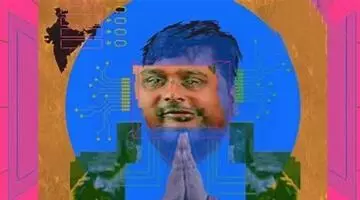Game of Clones: When Politicians Battle Their AI Doppelgängers in the Internet of Things

Picture this: You wake up tomorrow to find your local MLA dancing to "Tauba Tauba” or “Barbie Girl" in a viral video, your MP telling you Hinge tips and tricks, and a panchayat leader confessing their undying love for pineapple on pizza. Amusing as these scenarios might seem, the recent ‘deepfake audio’ attack on Nationalist Congress Party (Sharad Pawar) leader Supriya Sule and Congress leader Nana Patole proves they’re not as far-fetched as they appear.
When her artificial doppelganger emerged spouting manufactured tales of Bitcoin scandals, it wasn't just another piece of fake news, it was a harbinger of our new political reality, where truth wears a synthetic mask and democracy performs a high-wire act without a safety net.
Remember when the worst thing a politician had to worry about was a hot mic moment or an unfortunately timed photograph? Those were the good old days. Now, as India approaches crucial elections, we find ourselves in uncharted territory where every politician potentially has a digital twin capable of saying or doing anything.
The Sule incident isn't merely about one fabricated video; it's about the dawn of an era where political discourse itself is up for algorithmic manipulation. It's like having a political ventriloquist dummy that speaks in 22 official languages, plus dialects – and even the politician's own mother might be confused about which version of their child to believe.
The real mastery – and danger – of deepfake technology isn't in the grand political theatres of Delhi but in the hyperlocal battlegrounds where Indian democracy truly lives. Village-level testimonials are being manufactured faster than fake designer handbags in Palika Bazaar. These aren't just random videos; they're precision-guided political missiles, targeting voters with the accuracy of a GPS system that, for once, actually works in India. A candidate can seemingly appear at a local temple, address a village gathering in perfect Bhojpuri, and attend a community function in Tamil Nadu – all simultaneously, all fabricated, all crafted to exploit local grievances and aspirations with devastating precision.
Coalition politics in India was already more complicated than a daily soap opera's plot. Now add deepfake technology to the mix. Suddenly, that private conversation between alliance partners isn't so private when an AI can fabricate entire meetings. Before you can say "floor test," your carefully constructed coalition is falling apart faster than a Parle G in hot chai. The technology doesn't just exploit existing political fault lines; it creates new ones with the efficiency of a bureaucrat creating new departments.
In India's complex social fabric, deepfakes are like adding kerosene to an already sensitive situation. Our diversity, traditionally our strength, becomes a vulnerability when AI can craft customised provocations for every fault line in our social structure. Synthetic videos can show religious leaders making inflammatory statements they never made, create false evidence of caste-based confrontations, and generate communal tensions faster than a cricket match in the final over. It's like having a chaos generator that understands every nuance of Indian society and knows exactly which buttons to push for maximum drama.
The poor Election Commission of India, already juggling more balls than a circus performer, now needs more than just a software update to its Model Code of Conduct. They're trying to regulate digital content with rules that were probably written when fax machines were considered cutting-edge technology. What we need are AI detection systems more sophisticated than a Bengaluru traffic signal and digital authentication protocols stronger than your grandmother's ginger tea.
Beyond elections, this technology has begun infiltrating the sacred halls of governance. Public sentiment is being manufactured through synthetic protests and manipulated data, making policy-making as reliable as a weather forecast during climate change. AI-generated "expert" opinions are shaping legislative debates, while fake economic indicators send markets into tailspins faster than you can say "algorithmic trading." It's democracy by simulation, where public opinion is increasingly artificial but the consequences remain painfully real.
The solutions, while complex, must be as innovative as the threats they address. First, we need a robust technological framework for digital content authentication – think of it as an Aadhaar card for political content. The Election Commission must establish a specialised AI monitoring cell with real-time detection capabilities and the power to take immediate action against synthetic content. Political parties must be required to register all AI-generated content and face penalties more severe than a mother's disappointment at a failed IIT entrance exam.
Second, we need a massive digital literacy campaign that goes beyond basic technology awareness. Voters need to be trained in detecting synthetic content with the same vigilance that aunties apply to judging wedding arrangements. This isn't just about technical knowledge – it's about cultivating a healthy scepticism in our digital democracy.
Third, we need legislative reform that treats political deepfakes as seriously as we treat election fraud. While complete prevention may be impossible, we can create strong deterrents through legal frameworks backed by fast-track courts that move faster than a Mumbai local train (okay, maybe that's asking too much).
Finally, we need to build a collaborative ecosystem between political parties, technology experts, civil society, and media organisations. Independent fact-checking networks need to be strengthened, and media organisations must invest in verification technologies more sophisticated than a South Indian coffee filter. Political parties must collectively agree to certain ethical boundaries in their use of AI, even as they compete for votes more fiercely than uncles at a wedding buffet.
As we navigate this brave new world where every politician has a digital duplicate, perhaps it's time to update our old political wisdom. "All that glitters is not gold" now needs a digital addendum: "All that's viral is not valid." The future of Indian democracy depends on our ability to distinguish the real from the synthetic, the authentic from the artificial, the actual neta from their digital ‘natakbaaz.’
The Supriya Sule incident should serve as our wake-up call – a reminder that the integrity of our democracy now depends as much on our ability to guard against digital manipulation as it does on our ability to cast votes. The battle for Indian democracy's future will be fought not just at polling booths but in the digital realm where reality itself is increasingly up for grabs.
Welcome to Digital Democracy 2.0, where preserving truth is becoming as crucial as preserving law and order, and the only thing more fake than campaign promises might be the campaign videos themselves. May the real politician please stand up? (If we can figure out which one that is.) Buckle up, ‘ae mere watan ke logon’ – this ride is going to be wilder than a monsoon session of Parliament.
